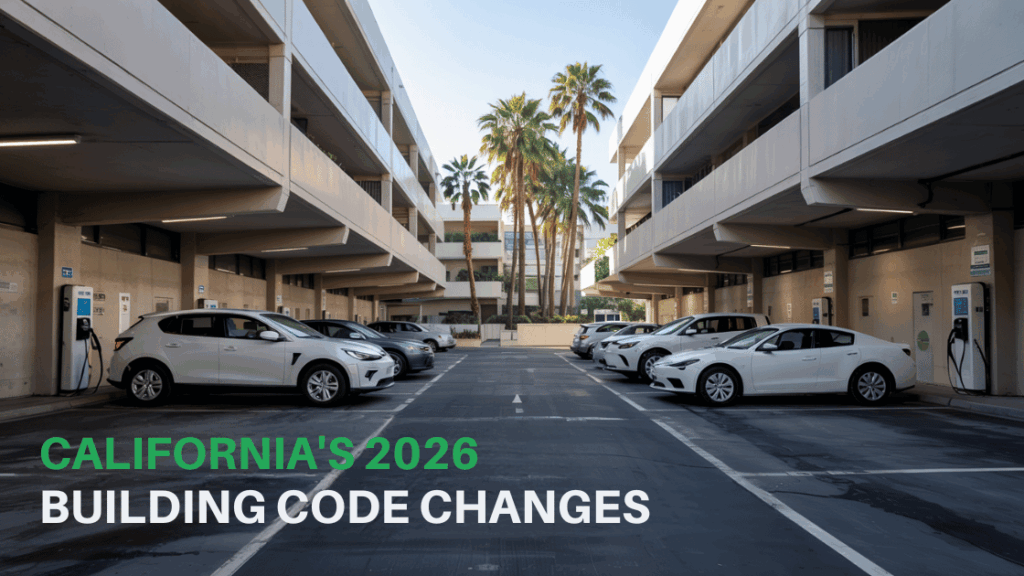Effective January 1st, California’s 2026 Building Code introduces the biggest changes in years, reshaping how you plan, design, and build projects across the state.
Whether you’re developing single-family homes or commercial high-rises, these updates may affect your plan approvals, submittal requirements and timelines. Proper due diligence reports are now more critical than ever to ensure your projects align with the new code requirements.
Here’s what’s changing and how to stay ahead:
Electric Systems Become the Standard
The 2026 code pushes hard toward electric appliances and heat pumps.
Gas isn’t banned outright, but the new efficiency standards make electric the obvious choice for most projects. California wants 500,000 new heat pump installations soon, with six million homes running electric heat pumps by 2030.
Commercial property owners face mandatory upgrades too. Old, oversized rooftop HVAC systems must be replaced with high-efficiency units. Most of the time, that means heat pumps. This change alone will create a wave of renovation projects across California’s commercial sector.
Every New Building Needs EV Charging
The 2026 code makes electric vehicle infrastructure mandatory, not optional. Every new multifamily building must be 100% EV ready. The requirements depend on your parking setup.
Buildings with assigned parking need at least one Level 2 EV charging receptacle per unit.
Buildings with shared or unassigned parking must install charging receptacles at every single spot. This represents a major infrastructure investment that needs to be factored into your project from day one.
Wildfire Protection Gets Serious
California’s wildfire crisis has created a new Wildland Urban Interface code. This replaces the old CBC Chapter 7A with standards based on recent wildfire lessons. The new WUI code brings stricter fire-rated vent requirements and better fire safety measures.
Projects in high-risk wildfire areas will see the biggest impact. The code aligns with international practices while keeping California’s specific needs in focus.
Smarter, Sustainable Buildings
The 2026 code requires smart technology for safety and energy management. Buildings must also include rainwater collection systems and sustainable materials as standard features, not upgrades.
Smart technology will also automate certain safety and energy management tasks, helping buildings operate more efficiently.
These rules show California’s commitment to resource conservation. Green building practices are now mandatory across all construction types.
Seismic Rules Change Everything
California’s earthquake safety requirements have shifted.
The biggest change limits seismic site classification to just the shear wave velocity (a method used to classify soil’s earthquake resistance). The old three-method approach is gone, and site classifications expand from five to eight categories.
This means more precise soil analysis for every project. Foundation design and structural requirements may change based on your specific site conditions.
High-Rise Buildings Face New Rules
High-rise classification now includes any occupied roof elevation, not just the highest occupied floor. This could reclassify existing building designs and change life safety system requirements.
Two-way communication systems in stairways and elevator lobbies must now meet NFPA 72 2025 edition standards. This adds complexity to high-rise construction projects.
More Clarity on Accessibility and Oversight
The state is also updating its accessibility rules, adding more detail and closing gaps in how alterations and new builds must comply. Inspector and lab certifications are also getting an overhaul, with higher standards for education and conduct.
The goal is consistency across jurisdictions. The result will likely mean more documentation, training, and attention to detail during inspection.
Why Professional Help Matters
The scope and complexity of these changes make expert permit expediting more valuable than ever. From EV charging requirements to new seismic classifications and wildfire protections, these rules require experience to implement efficiently.
At Permit Place, we’ve been tracking these developments and preparing our team to help clients through the transition smoothly. Our understanding of California’s permitting process and relationships with local jurisdictions help minimize delays and ensure compliance.
What Comes Next
The 2026 Building Code sets a bold new standard for the future of construction in California. It prioritizes sustainability, safety, and technology integration. The changes present challenges but also create opportunities for innovation and leadership.
How to Stay Ahead
Our permitting team works across all California cities, and we’ve already begun preparing for the 2026 cycle. Whether you’re managing one site or many, we can help:
- Review: Examine your current designs to identify areas needing adjustments.
- Coordinate: Work with local reviewers and inspectors to ensure no surprises.
- Stay Updated: Keep track of WUI zones, EV capacity requirements, seismic reporting, and more.
If you’re planning a new project, or even breaking ground in late 2025, these changes are already relevant.

